Please click on the images to see a larger image and a brief description.
Introduction:
The Pyramid South AC/DC exchange system was created during the early 1980's to allow the newly electrified 25 kv AC 50 hz hauled trains headed to and from the north (Pietersburg) and the west (Rustenburg and beyond to Thabazimbi) to change over to the existing 3 kv DC haulage that is the standard throughout the Pretoria - Witwatersrand - Vereeniging region.
The Pyramid South locomotive shed is home to the AC locomotive fleet deployed throughout the northern portion of South Africa. The shed performs maintenance and heavy repairs to the 7E and 7E2 class locomotives. Diesel traction can also be seen in the AC locomotive yard along with the dual mode class 38 electro-diesels (3kvdc + CAT diesel).
Only a short walking distance away and to the north of the locomotive shed, is the DC locomotive yard. The Pyramid South AC shed does not perform repairs to the DC locomotives other than minor issues. Instead, the maintenance and repairs to the DC fleet are carried out at the Sentrarand locomotive shed (and other DC e-lok sheds).
The interesting traffic flows running through Pyramid South are the export loads headed for tidewater at Richards Bay. For these class 7E and 7E2 AC hauled trains coming in from the north and west must change to DC traction for the short DC run from Pyramid South to the AC/DC exchange yard located at Ermelo. Once at the Ermelo AC/DC exchange yard, the DC units are replaced by the AC traction classes 7E1 and 7E3 locomotives, and the loads then continue down to Richards Bay.
The late 1990's vintage dual-current class 14E locomotives can of course, run through the AC/DC barrier. However, as so many single current AC and DC locomotives are in active service, the AC/DC exchange yards located throughout South Africa are not in danger of being phased-out.
Notice that when one speaks of the 7E units, this refers to the first batch of units delivered during the late 1970's. The South African Transport Services eventually placed orders for three more groups of the 7E units. Thus, the 7E1, 7E2, and the 7E3 classes.
The 7E series of electric locomotives are categorized based on the following number series:
- 7E, #7001 - 7100. Electrical by the 50Hz Group, mechanical by Union Carriage & Wagon.
- 7E1, #7101 - 7102. Hitachi, Japan.
- 7E1, #7103 - 7150. Electrical by Hitachi, mechanical by Dorbyl.
- 7E2, #7151 - 7215. Electrical by the 50Hz Group, mechanical by Union Carriage & Wagon.
- 7E3, #7216 - 7300. Electrical by Hitachi, mechanical by Dorbyl.
Notes: 50 Hz Group leader for the South African 7E program was Siemens. 7E1 units have only one
cabin and operating stand.
For a good understanding of the South African Railway locomotive class and numbering
system, see "Railways of Southern Africa - Locomotive Guide 2002", by John N. MIDDLETON,
Beyer-Garratt Publications, 2002.
|
AC and Diesel Locomotive Yard.
This loco yard (AC loco yard) has its very busy moments followed by periods of inactivity. All this makes for very good railway photography as the scene changes and then holds constant for a sufficient time to take some images.
The first three images show the basic layout of the AC locomotive yard as I walked from the main office out to the shop. At that time, three separate movements were taking place, so I could not linger in the yard. The class 38 pair was being made up, some 7E's coming in, others going out. Once the dust settled, and with a safety guide person, I could get close to the 38's.
|
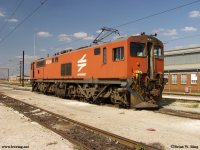
| 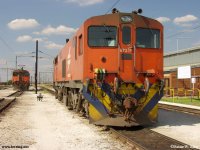
|
|
|
|
38-027
Here we have a pair of dual mode units, 3kv DC + CAT diesel, under the 25kv AC wire. Raise that panto and close the MCB and all heck will break.
These class 38's are extremely useful units and they are very common to see in and around the Pretoria area.
Shown here are images of 38-027 and 38-042. As the units are long-hood to long-hood, the details of each side were easy to record and are shown here to hopefully assist any
modelers. As the track to my back was active, I could not step back any further. Thus the images have some visible short focal length distortion.
|
|
Service Tracks
The first tracks after the AC loco yard are the AC service tracks. Here can be found the active units being checked over and any minor repairs being performed. As the shop interior was very busy, and I did not want to upset the workflow, I have no images to show of the service shop work floor.
|
|
7E2 #7182
Here we have a unit in the dark brown Spoornet livery.
|
|
7E2 #7185
Here we have a unit in the newer all blue Spoornet livery. Rather sharp looking and the gray coloured
under frame and bogies are good for hiding the road dirt.
|
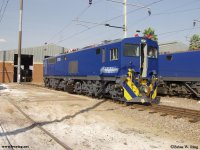
| 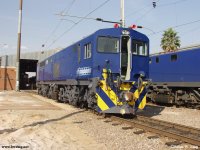
|
|
|
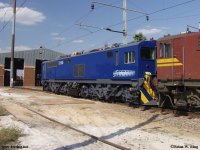
| 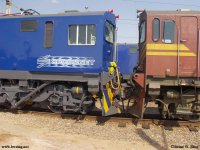
|
|
|
|
Repair and Parts
The tracks furthest away from the main office are the long term storage tracks. At this location are units that are in the process of being repaired or used as a source for parts.
While the term 'as a source for parts' sounds rather bad, one must recall that South Africa does not have a large railway stockpile to draw upon. One can not just go back to the local source for 'one of these' and 'one of that'. Thus, this is what has become of the early 1980's vintage GTO controlled, DC traction motor, six-axle fleet.
A cheerful side note: as the Spoornet diesel fleet closely resembles that of the North American versions of both the EMD and GE models, the diesel fleet can draw upon rather standard components. For this reason alone, the South African electric traction locomotives that are part of a small fleet quantity, such as the 11E units used on the Coal Line, may face a difficult future. Therefore, as ugly as it seems to see the cannibalization of the 7E class units, this process will most
likely allow the fleet to perhaps survive a few more decades.
So ..... get your photos now. Nuff said.
The line-up.
|
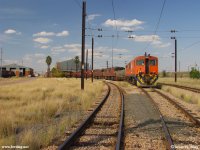
|
|
|
|
|
7E #7058
Other then the road number, 7058, a 7E can be spotted by the round corners of the cab side access doors.
|
|
7E2 #7160
Hello old friend. This was the first South African AC traction locomotive that I rode on 09 August 1984. I was
traveling from Pretoria to Columbia (a station sign stop at the Rustenburg Platinum Mine) and at Brits the passenger train changed from the class 34 diesel #631 to this 7E2 #7160.
|
|
Service and inspection tracks.
|
|
First AC loco and two strays.
The first image shows a side view of E1600, the first AC loco in South Africa. This unit was the test machine for the South African Railways to formulate a specification for the supply of the 7E fleet. The center image shows off the number plate that somehow is somehow still attached to the unit. The final image shows E1600 in the distance, 7E2 #7203, and upfront 7E2 #7194. The 7E2 units were involved in a bump and are now a source for parts.
|
|
DC Locomotive Yard.
The DC locomotive yard is only a short walk from the AC facility. The traction sand tower provides as a good landmark.
|
|